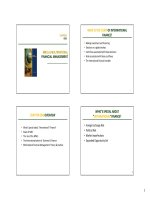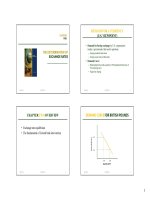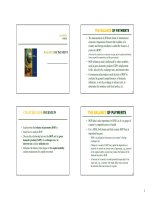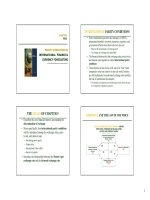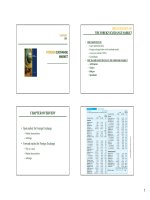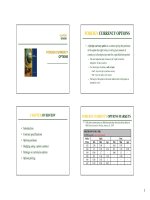Multinational financial management 7th CH05
Bạn đang xem bản rút gọn của tài liệu. Xem và tải ngay bản đầy đủ của tài liệu tại đây (866.23 KB, 37 trang )
Multinational Financial
Management
Alan Shapiro
7th Edition
J.Wiley & Sons
Power Points by
Joseph F. Greco, Ph.D.
California State University, Fullerton
1
CHAPTER 5
THE BALANCE OF
PAYMENTS AND
INTERNATIONAL
LINKAGES
2
CHAPTER OVERVIEW
I.
BALANCE-OF-PAYMENT
CATEGORIES
II. THE INTERNATIONAL
FLOW OF GOODS,
SERVICES,AND CAPITAL
III. COPING WITH CURRENT
ACCOUNT DEFICITS
3
PART I. BALANCE-OF-PAYMENT
CATEGORIES
A.
THE BALANCE OF PAYMENTS
(B-O-P)
1. PURPOSE:
Measures all financial and
economic transactions over
a specified period of time.
4
BALANCE-OF-PAYMENT
CATEGORIES
2. Double-entry bookkeeping
a.
Currency inflows = credits
earn foreign exchange
b.
Currency outflows = debits
expend foreign exchange
5
BALANCE-OF-PAYMENT
CATEGORIES
3. Three Major Accounts:
a. Current
b. Capital
c. Official Reserves
4. Current Account
records net flow of goods,
services, and unilateral transfers.
6
BALANCE-OF-PAYMENT
CATEGORIES
5. Capital Account
a. Function: records public
and private investment
and
lending.
b. Inflows = credits
c. Outflows = debits
7
BALANCE-OF-PAYMENT
CATEGORIES
5. Capital Account (con’t)
d. Transactions classified as
1.) portfolio
2.) direct
3.) short term
8
BALANCE-OF-PAYMENT
CATEGORIES
6. Official Reserves Account
a. Function:
1.) measures changes in
international reserves
owned by central banks.
2.) reflects surplus/deficit of
a.) current account
b.) capital account
9
BALANCE-OF-PAYMENT
CATEGORIES
6. Official Reserves Account (con’t)
b. Reserves consist of
1.) gold
2.) convertible securities
10
BALANCE-OF-PAYMENT
CATEGORIES
7. Net Effects:
a.
Sum of all transactions
must be zero:
1.) current account
2.) capital account
3.) official reserves
11
BALANCE-OF-PAYMENT
CATEGORIES
8. The Balance-of-payment measures
a. Some Definitions:
1.) Basic Balance
a.)
flows.
consists of current
account and long-
term capital
12
BALANCE-OF-PAYMENT
CATEGORIES
1.) Basic Balance (con’t)
b.) emphasizes longterm trends.
13
BALANCE-OF-PAYMENT
CATEGORIES
1.) Basic Balance (con’t)
c.) excludes short-term capital
flows that heavily depend
on
temporary factors.
14
BALANCE-OF-PAYMENT
CATEGORIES
2.) Net Liquidity Balance:
measures the change in
private domestic borrowing
or lending require to keep
payments equal without
adjusting official reserves.
15
BALANCE-OF-PAYMENT
CATEGORIES
3.)
Official Reserve Transactions
Balance
-
measures adjustments
needed by official
reserves.
16
PART II. THE INTERNATIONAL FLOW OF
GOODS, SERVICES, AND CAPITAL
II.LINKS FROM INTERNATIONAL
TO DOMESTIC FLOWS
A. Global Linkages
set of basic macroeconomic
identities which link:
domestic spending and
production to current and
capital accounts
17
THE INTERNATIONAL FLOW OF
GOODS, SERVICES, AND CAPITAL
B.
Domestic Savings and Investment
and the Capital Account
1. National Income Accounting
a.
National Income (NI) is either spent (C)
or saved (S)
NI = C + S (5.1)
18
THE INTERNATIONAL FLOW OF
GOODS, SERVICES, AND CAPITAL
b.
National spending (NS) is
divided into personal
spending (C) and
investment (I)
NS = C + I
(5.2)
19
THE INTERNATIONAL FLOW OF
GOODS, SERVICES, AND CAPITAL
c.
Subtracting (4.2) - (4.1)
NI - NS = S - I
(5.3)
If NI >NS, S > I which implies
that surplus capital spent
overseas.
20
THE INTERNATIONAL FLOW OF
GOODS, SERVICES, AND CAPITAL
d. In a freely-floating system,
excess saving = the capital
account balance
e. Implications:
1. A nation which produces more than
it spends will
save more than it
invests domestically with a net capital
outflow producing a
capital account
deficit.
21
THE INTERNATIONAL FLOW OF
GOODS, SERVICES, AND CAPITAL
2. A nation which spends more
than
it produces has a net capital inflow
producing a capital account
surplus.
3. A healthy economy will tend to
run a current account deficit.
22
THE INTERNATIONAL FLOW OF
GOODS, SERVICES, AND CAPITAL
C.
THE LINK BETWEEN THE
CURRENT AND CAPITAL
ACCOUNTS
1.
Beginning identity
NI - NS = X - M
(5.4)
where X = exports
M = imports
X-M=current account
balance (CA)
23
THE INTERNATIONAL FLOW OF
GOODS, SERVICES, AND CAPITAL
2.
3.
Combining (5.3) + (5.4)
S - I = X - M
(5.5)
If S - I = Net Foreign
Investment (NFI)
NFI = X - M
(5.6)
24
THE INTERNATIONAL FLOW OF
GOODS, SERVICES, AND CAPITAL
4. Implications:
a.
If CA is in surplus, the
nation must be a net
exporter of capital.
b.
If CA is a deficit, the nation
is a major capital importer.
c.
When NS > NI, the excess
must be acquired through
foreign trade.
25

